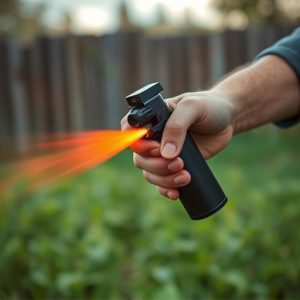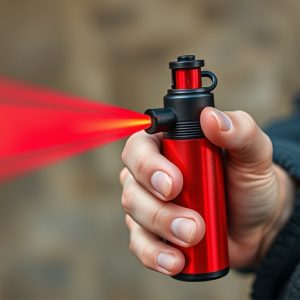Police-Grade Pepper Spray: Decontamination Steps for Safe Use at Home
TL;DR:After exposure to pepper spray, immediate home decontamination is crucial. This involves remov…….
TL;DR:
After exposure to pepper spray, immediate home decontamination is crucial. This involves removing contaminated clothing, rinsing affected areas with clean water for 15 minutes, using a soapy solution, and gently patting dry. Seek medical attention if irritation persists, as professional care may be needed to prevent lasting effects. Key steps include proper ventilation, protective gear, evacuation, and specific cleaning methods using non-ammonia cleaners. Milk and soap are ineffective against capsaicin; instead, follow evidence-based practices for safe decontamination.
“Uncover the power of police-grade inflammatory pepper spray and its profound impact on personal safety. This comprehensive guide delves into the science behind this potent compound, offering a detailed look at its uses and how it works. From understanding its chemical composition to exploring practical decontamination steps, we provide essential knowledge for home use. Learn safe practices, dispel common misconceptions, and discover effective remedies for pepper spray exposure. Master the art of Pepper Spray Decontamination Steps at Home.”
- Understanding Pepper Spray Compound and Its Uses
- The Science Behind Police-Grade Pepper Spray
- Safety Precautions for Home Decontamination
- Step-by-Step Guide to Pepper Spray Decontamination
- Common Misconceptions and Debunking Mythical Remedies
Understanding Pepper Spray Compound and Its Uses
Pepper spray, a powerful compound designed for law enforcement and self-defence purposes, contains capsaicin, a natural chemical derived from chili peppers. This substance is known for its ability to cause temporary but intense discomfort, hindering an attacker’s mobility and providing users with an opportunity to escape or seek help. The spray is widely used by police forces globally due to its effectiveness in de-escalating potentially dangerous situations.
When exposed to pepper spray, the eyes water, coughing and breathing become difficult, and vision becomes blurred. These symptoms are usually short-lived, lasting from a few minutes to an hour, but they can be extremely unpleasant. Understanding the decontamination steps after exposure to pepper spray is crucial, especially for those who may have been involuntarily exposed during incidents involving law enforcement or in self-defence scenarios at home. Simple decon steps include moving to an area with fresh air, removing contaminated clothing, and thoroughly washing affected areas with soap and water.
The Science Behind Police-Grade Pepper Spray
Pepper spray, a powerful tool used by law enforcement worldwide, is a specialized compound designed to incapacitate and disrupt an individual’s ability to fight or flee in a short duration. The active ingredient in most police-grade pepper sprays is capsaicin, a chemical derived from chili peppers. This substance is responsible for the burning sensation and temporary blindness it causes when in contact with mucous membranes.
The decontamination steps after exposure to police-grade pepper spray are crucial. At home, immediate action involves removing contaminated clothing and washing the eyes, skin, and any open wounds with plenty of clean water. This helps to dilute the capsaicin and prevent further irritation or damage. It’s important to note that while these DIY measures can provide relief, medical attention is recommended if symptoms persist or severe reactions occur, especially in young children, the elderly, or those with pre-existing respiratory conditions.
Safety Precautions for Home Decontamination
When decontaminating your home after exposure to pepper spray, safety should be your top priority. Start by ensuring the area is well-ventilated to disperse any remaining chemical residue. Put on protective gear, including gloves and a respirator or mask, to shield yourself from direct contact or inhalation of the spray. Evacuate anyone who was present during the incident to a safe, remote location until the decontamination process is complete.
Follow these pepper spray decontamination steps at home: first, remove any contaminated clothing and wash thoroughly with soap and warm water. Next, clean all surfaces using a non-ammonia based cleaner to avoid triggering any irritations. Pay close attention to high-touch areas like doorknobs, light switches, and countertops. After cleaning, dispose of the cleaning materials properly in sealed bags. Finally, wash your eyes gently with clean water if they’ve been exposed, and seek medical advice if irritation persists.
Step-by-Step Guide to Pepper Spray Decontamination
After being exposed to pepper spray, immediate decontamination is crucial for effective removal and minimizing discomfort. Here’s a step-by-step guide to pepper spray decontamination steps at home:
1. Remove Contaminated Clothing: As swiftly as possible, doff any clothing that has come into contact with the pepper spray. Fold or tie these items securely in a plastic bag for later disposal or laundering.
2. Rinse Affected Areas: Rinse eyes thoroughly with clean water for at least 15 minutes. If available, use eye lavage solutions designed to irrigate and flush out irritants. For skin exposure, gently wash the affected areas with mild soap and plenty of warm water. Continue rinsing until all pepper spray residue is eliminated.
3. Use a Soapy Solution: Prepare a solution of warm water and mild liquid soap (like dishwashing detergent). Apply this solution to any remaining pepper spray deposits on the skin or clothing using a soft cloth or sponge. Rinse thoroughly again afterward.
4. Dry Off: Pat dry the affected areas gently with a clean towel. Avoid rubbing, which could further irritate sensitive skin. For clothing, allow it to air-dry completely before wearing again.
5. Seek Medical Attention if Necessary: If irritation persists or deepens, especially in the eyes, seek immediate medical attention. A healthcare professional can provide additional care and ensure no lasting effects occur.
Common Misconceptions and Debunking Mythical Remedies
Many people have misconceptions about how to decontaminate after being exposed to pepper spray. A common myth is that drinking milk or using soap and water can neutralize the chemical. However, these remedies are not effective against pepper spray compounds, which are designed to disrupt respiratory and ocular functions. The active ingredients in pepper spray, like capsaicin, remain potent and cannot be washed away with simple household solutions.
When seeking Pepper Spray Decontamination Steps at Home, it’s crucial to understand the science behind these products. The best approach is to flush affected areas with plenty of water for at least 15 minutes, ensuring thorough rinsing. Eye irrigation or a cold compress can help alleviate discomfort in the eyes and face. Medical attention should be sought if irritation persists or severe symptoms develop, as professional care may be necessary to address any potential health risks associated with pepper spray exposure.
Pepper spray, specifically police-grade formulations, is a powerful tool for self-defense and law enforcement. However, its misuse or improper handling can lead to severe health risks. Understanding the science behind this compound and following exacting decontamination steps, as outlined in this article, are crucial for both safe application and effective home decontamination. By adhering to these pepper spray decontamination steps at home, individuals can minimize exposure risks and ensure a thorough clean-up process.


